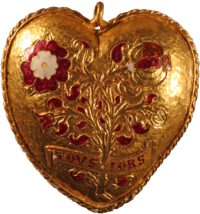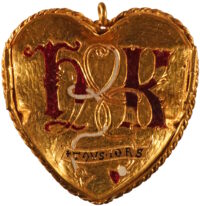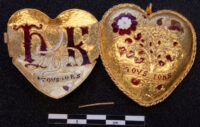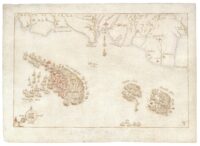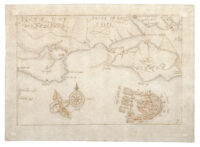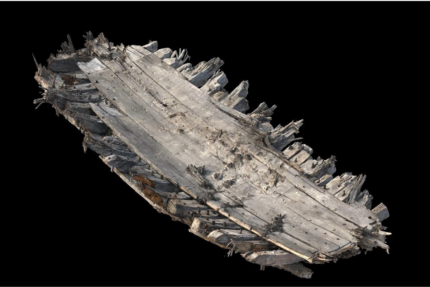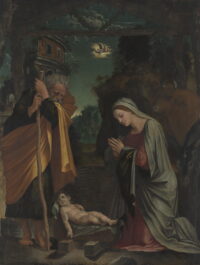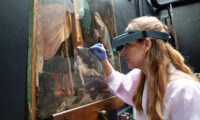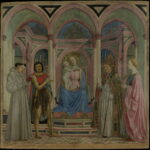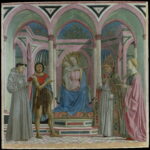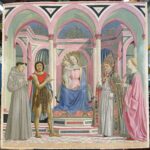 A unique gold and enamel heart-shaped pendant bearing the initials and emblems of King Henry VIII and Katherine of Aragon has been unveiled at the British Museum. It is in impeccable condition and of such exceptionally high quality that it could plausibly be connected to the royal couple themselves.
A unique gold and enamel heart-shaped pendant bearing the initials and emblems of King Henry VIII and Katherine of Aragon has been unveiled at the British Museum. It is in impeccable condition and of such exceptionally high quality that it could plausibly be connected to the royal couple themselves.
The jewel was discovered by Birmingham café owner Charlie Clarke while metal detecting in a field in Warwickshire on a very auspicious Friday the 13th, December, 2019. After his screaming abated, Clarke notified the Finds Liaison Officer who in turn contacted Historic England. A subsequent excavation of the find site did not return any further artifacts.
The pendant is a heart-shaped locket enameled in red and white on both sides. The obverse is decorated with an engraved floral design in the center. Accented with translucent red enamel leaves, the stalk splits into two with a red and white enamel Tudor rose on the left and a pomegranate, emblem of Katherine of Aragon, on the right.
The reverse features a central design of an “H” and a “K” in Lombardic script entwined with a ribbon. The initials are enamelled in red, the ribbon with white. The ribbon ends with a thistle-shaped tassel in red and white enamel.
Both sides have a banner unfurled at the bottom inscribed with red enamel lettering reading: + TOVS + IORS. That same inscription is on the reverse of the pendant under the initials only with black enamel. This is the French “toujours” (meaning “always”) broken into two parts. Iterations of this inscription have been found on other pieces from the post-medieval period, for example this simple gold posy ring from the 16th or 17th century inscribed on the inner band: + TOVT IOVRS LOIALL (“forever faithful”). Rachel King, curator of Renaissance Europe at the British Museum, thinks the pendant’s inscription may also be a play on words, splitting “toujours” into “tous” (French for “all”) and “iors,” which is phonetically the same as the English “yours.”
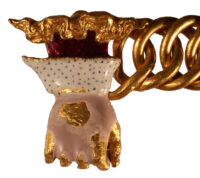 The chain consists of 75 links for a total length of 17.2 inches. At one of the chain is a red and white enamelled, begloved hand at one end. The hand is clenched in a fist with fingers curved back under the thumb flat against the side. The cuff of the glove is white enamel with black speckles suggesting ermine trim. A rectangular sleeve decorated in translucent red enamel extends past the cuff. The other end of the chain was modified at some point to create a hinged clasp behind the glove.
The chain consists of 75 links for a total length of 17.2 inches. At one of the chain is a red and white enamelled, begloved hand at one end. The hand is clenched in a fist with fingers curved back under the thumb flat against the side. The cuff of the glove is white enamel with black speckles suggesting ermine trim. A rectangular sleeve decorated in translucent red enamel extends past the cuff. The other end of the chain was modified at some point to create a hinged clasp behind the glove.
The whole necklace, chain and pendant, weighs 317 grams of 24K gold. It is very high in gold content even in its most minute parts. The suspension loop, hinges, wire border are more than 98% gold, with just a trace of silver and a soupçon of copper.
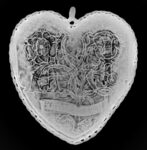 British Museum researchers were able to narrow down the date of the pendant based on the Lombardic script and decorative motifs. It was made later than 1509 and before 1530. That fits the political timeline as well. Henry married Katherine in 1509 and banished Katherine from court in 1531, so the market for entwined H&K initials on heart jewels came to a screeching halt at that time. Their marriage was annulled in 1533.
British Museum researchers were able to narrow down the date of the pendant based on the Lombardic script and decorative motifs. It was made later than 1509 and before 1530. That fits the political timeline as well. Henry married Katherine in 1509 and banished Katherine from court in 1531, so the market for entwined H&K initials on heart jewels came to a screeching halt at that time. Their marriage was annulled in 1533.
Despite initially seeming almost too good to be true, said King, careful scientific analysis has proved the pendant to be genuine. What experts have not been able to uncover, however, despite scouring inventories and pictures of the time, is to establish a personal link to Henry or Katherine.
“Nonetheless, its quality is such that it was certainly either commissioned by or somehow related to a member of the higher nobility or a high-ranking courtier.”
One hypothesis, based on careful analysis of its iconography and other historical records, is that the pendant may have been commissioned to be worn or even given as a prize at one of the major tournaments of which Henry was so fond, around the time of the famous Field of the Cloth of Gold in 1520. Though its size suggests it would only fit a woman, it may not have been meant to be worn at all.
Nothing remotely similar survives from the period, said King. “In the British Museum, we’ve got the largest collection of objects from the early Tudor periods in precious metal; none of them are anything like this.”
